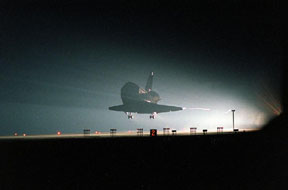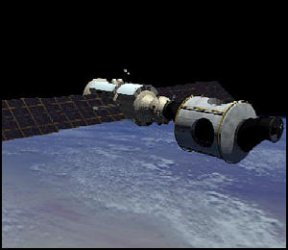This is an artist's depiction of the ISS before the Zvezda docking. The Unity is on the right and the Zarya is on the left.
Click on image for full size
Courtesy of NASA
Let's Get on with the Show!
News story originally written on July 26, 2000
Finally! Two years of frustration and disappointment was overshadowed by the docking
of Russia's Zvezda module to the International Space Station. The module was flying
alone for two weeks while being tested. At speeds over 17,000 miles per hour, Zvezda
joined with the other two pieces of the station.
Scientists around the world applauded as the biggest hurdle yet faced by the ISS
was over. The Zvezda module is 43 feet long. It will serve as the sleeping and dining area
for the crew, the main power source for the station, as well as a small laboratory. The first crew will visit the ISS in November.
"The International Space Station has nearly doubled in size in just a few moments,"
NASA spokesman Rob Navias added from Houston.
Zvezda joins the U.S. Unity and the Russian Zarya in space. Zarya was the temporary
power source and will now serve as a passageway. The Unity is the docking port for future missions.
The main laboratory will be launched in January.
You might also be interested in:

The next shuttle mission will begin on September 8th. The Space Shuttle Atlantis will head to the International Space Station with plenty of supplies. The purpose of the visit is to prepare the station
...more
It was another exciting and frustrating year for the space science program. It seemed that every step forward led to one backwards. Either way, NASA led the way to a great century of discovery. Unfortunately,
...more
The Space Shuttle Discovery lifted off from Kennedy Space Center at 2:19 p.m. EST, October 29th. The sky was clear and the weather was great as Discovery took 8 1/2 minutes to reach orbit for the Unitied
...more
A moon was discovered orbiting the asteroid, Eugenia. This is only the second time in history that a satellite has been seen circling an asteroid. A special mirror allowed scientists to find the moon
...more
Will Russia ever put the service module for the International Space Station in space? NASA officials are demanding an answer from the Russian government. The necessary service module is currently waiting
...more
During a period of about two days in early May, 1998, the ACE spacecraft was immersed in plasma associated with a coronal mass ejection (CME). The SWICS instrument on ACE, which determines unambiguously
...more
J.S. Maini of the Canadian Forest Service has referred to forests as the "heart and lungs of the world." Forests reduce soil erosion, maintain water quality, contribute to atmospheric humidity and cloud
...more















